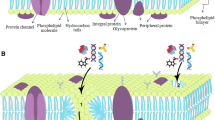Summary
Prior to fusion, gametes ofChlamydomonas reinhardii discard their cell walls. This naturally occuring phenomenon has provided the basis for a method of protoplast isolation from both gametes and vegetative cells within the genusChlamydomonas. When synchronized cultures of compatibleChlamydomonas gametes are mixed it is possible, after removal of the cells, to obtain a solution having a high cell wall lytic activity. That vegetative and gamete cells after treatment with this “gamete-autolysine” are indeed protoplasts has been proved by various light and electron microscopical methods.
The species specifity of this autolysine, its difference to the previously described “sporangialautolysine” (Schlösser 1966) and furthermore its use in the large scale production of protoplasts is also described. Since this wall autolysine is a factor produced by the cells themselves at a particular stage in their life cycle it represents a non-foreign agent in contrast to all other enzymic methods previously employed for protoplast isolation.
Similar content being viewed by others
References
Atkinson, A. W., B. E. S. Gunning, andP. C. L. John, 1972: Sporopollenin in the cell wall ofChlorella and other algae: Ultrastructure, chemistry and incorporation of14C-acetate, studied in synchronous cultures. Planta (Berl.)107, 1–32.
Branton, D., 1971: Freeze-etching studies of membrane structure. Phil. Trans. Roy. Soc. (Lond.)B 261, 133–138.
Bray, D. F., K. Nakamura, J. W. Costerton, andE. B. Wagenaar, 1974: Ultrastructure ofChlamydomonas eugametos as revealed by freeze-etching: Cell wall, plasmalemma and chloroplast membrane. J. Ultrastruct. Res.47, 125–141.
Burczyk, J., H. Grzybek, J. Banás, andE. Banás, 1971: Presence of cellulase in the algaScenedesmus. Exp. Cell Res.63, 451–453.
Claes, H., 1971: Autolyse der Zellwand bei den Gameten vonChlamydomonas reinhardii. Arch. Mikrobiol.78, 180–188.
Cocking, E. C., 1972: Plant cell protoplasts—isolation and development. Ann. Rev. Plant Physiol.23, 29–50.
— andP. K. Evans, 1973: The isolation of protoplasts. In: Plant tissue and cell culture, pp. 100–120. (H. E. Street, ed.). Oxford: Blackwell Sci. Publ.
Davies, D. R., andV. Lyall, 1973: The assembly of a highly ordered component of the cell wall: The role of heritable factors and of physical structure. Molec. gen. Genetics124, 21–34.
Deason, T. R., 1967:Chlamydomonas gymnogama, a new homothallic species with naked gametes. J. Phycol.3, 109–112.
Franke, W. W., S. Krien, andR. M. Brown, Jr., 1969: Simultaneous glutaraldehydeosmium tetroxide fixation with postosmication, an improved fixation procedure for electron microscopy of plant and animal cells. Histochemie19, 162–164.
Gabriel, M., 1970: Formation, growth, and regeneration of protoplasts of the green alga,Uronema gigas. Protoplasma70, 135–138.
Hills, G. J., 1973: Cell wall assemblyin vitro fromChlamydomonas reinhardii. Planta (Berl.)115, 17–23.
—,M. Gurney-Smith, andK. Roberts, 1973: Structure, composition, and morphogenesis of the cell wall ofChlamydomonas reinhardii. II. Electron microscopy and optical diffraction analysis. J. Ultrastruct. Res.43, 179–192.
Horne, R. W., D. R. Davies, K. Norton, andM. Gurney-Smith, 1971: Electron microscope and optical diffraction studies on isolated cell walls fromChlamydomonas. Nature (Lond.)232, 493–495.
Hoshaw, R. W., andH. Ettl, 1966:Chlamydomonas smithii sp. nov.—a chlamydomonad interfertile withChlamydomonas reinhardii. J. Phycol.2, 93–96.
Klebs, G., 1896: Die Bedingungen der Fortpflanzung bei einigen Algen und Pilzen, pp. 424–438. Jena: G. Fischer.
Kuhl, A., 1962: Zur Physiologie der Speicherung kondensierter anorganischer Phosphate. In: Beiträge zur Physiologie und Morphologie der Algen, pp. 157–164. Stuttgart: G. Fischer.
— andH. Lorenzen, 1964: Handling and culturing ofChlorella. In: Methods in cell physiology. Vol. I, pp. 159–187. (D. M. Prescott, ed.). New York: Academic Press.
Lorenzen, H., 1957: Synchrone Zellteilungen vonChlorella bei verschiedenen Licht-Dunkel-Wechseln. Flora (Jena)144, 473–496.
Miller, D. H., D. T. A. Lamport, andH. Miller, 1972: Hydroxyproline heterooligosaccharides inChlamydomonas. Science176, 918–920.
—,I. S. Mellman, D. T. A. Lamport, andM. Miller, 1974: The chemical composition of the cell wall ofChlamydomonas gymnogama and the concept of a plant cell wall protein. J. Cell Biol.63, 420–429.
Pascher, A., 1943: Beiträge zur Morphologie der ungeschlechtlichen und geschlechtlichen Vermehrung der GattungChlamydomonas. Beih. Biol. Centralblatt Abt.A 62, 197–220.
Potrykus, I., 1973: Isolation, fusion and culture of protoplasts ofPetunia. In: Yeast, mould and plant protoplasts, pp. 319–332. (J. R. Villanueva, I. García-Acha, S. Gáscon, andF. Uruburu, eds.). London-New York: Academic Press.
Roberts, K., 1974: Crystalline glycoprotein cell walls of algae: their structure, composition and assembly. Phil. Trans. Roy. Soc. (Lond.)B 268, 129–146.
—,M. Gurney-Smith, andG. J. Hills, 1972: Structure, composition and morphogenesis of the cell wall ofChlamydomonas reinhardii. I. Ultrastructure and preliminary chemical analysis. J. Ultrastruct. Res.40, 599–613.
Ruesink, A. W., 1971: Protoplasts of plant cells. In: Methods in enzymology, Vol. 23, pp. 197–209. (A. San Pietro, ed.). London-New York: Academic Press.
Sager, R., andS. Granick, 1953: Nutritional studies withChlamydomonas reinhardii. Ann. N.Y. Acad. Sci.56, 831.
— — 1954: Nutritional control of sexuality inChlamydomonas reinhardii. J. gen. Physiol.37, 729–742.
Schlösser, U., 1966: Enzymatisch gesteuerte Freisetzung von Zoosporen beiChlamydomonas reinhardii Dangeard in Synchronkultur. Arch. Mikrobiol.54, 129–159.
Skuja, H., 1963: Die geschlechtliche Reproduktion einer Monade aus dem Formenkreis vonChlamydomonas tecta. Svensk. Bot. Tidskr.57, 243–252.
Van der Woude, W. J., D. J. Morré, andC. E. Bracker, 1971: Isolation and characterization of secretory vesicles in germinating pollen ofLilium longiflorum. J. Cell Sci.8, 331–351.
Villanueva, J. R., andI. García-Acha, 1971: Production and use of fungal protoplasts. In: Methods in microbiology. Vol. 4, pp. 665–718. (C. Booth, ed.). London-New York: Academic Press.
Villanueva, J. R., I. García-Acha, S. Gáscon, andF. Uruburu (eds.), 1973: Yeast, mould and plant protoplasts. London-New York: Academic Press.
Wiese, L., 1965: On sexual agglutination and mating-type substances (gamones) in isogamous heterothallicChlamydomonads. I. Evidence of the identity of the gamones with surface components responsable for sexual flagellar contact. J. Phycol.1, 46–54.
— 1974: Nature of sex specific glycoprotein agglutinins inChlamydomonas. Ann. N.Y. Acad. Sci.234, 383–395.
Author information
Authors and Affiliations
Rights and permissions
About this article
Cite this article
Schlösser, U.G., Sachs, H. & Robinson, D.G. Isolation of protoplasts by means of a “species-specific” autolysine inChlamydomonas . Protoplasma 88, 51–64 (1976). https://doi.org/10.1007/BF01280359
Received:
Revised:
Issue Date:
DOI: https://doi.org/10.1007/BF01280359




